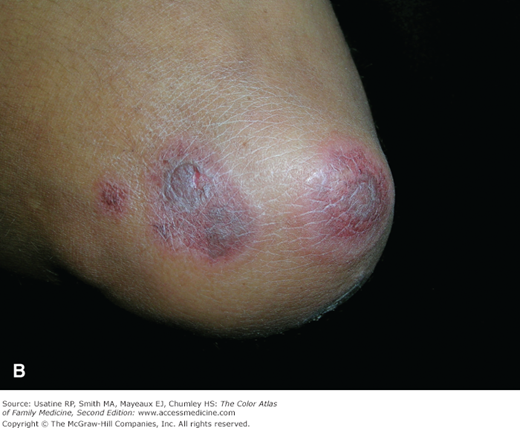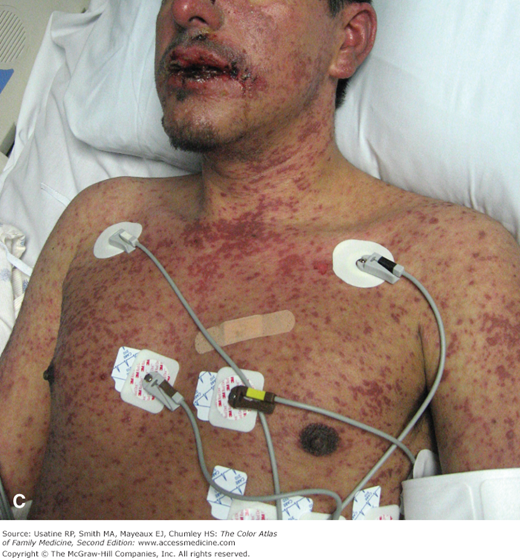Patient Story
A 14-year-old boy presents to the emergency department with a 1-day history of fever associated with lip swelling and peeling (Figure 177-1A). Within 48 hours he developed involvement of his ocular (Figure 177-1B) and urethral mucosa along with an erythematous papular rash on his trunk that spread to his extremities. In Figure 177-1C target lesions can be seen on the back. He was diagnosed with Stevens-Johnson syndrome and admitted to the hospital.
Introduction
Erythema multiforme (EM), Stevens-Johnson syndrome (SJS), and toxic epidermal necrolysis (TEN) are skin disorders thought to be types of hypersensitivity reactions (undesirable reactions produced by a normal immune system in a presensitized host) that occur in response to medication, infection, or illness. Both SJS and TEN are severe cutaneous reactions thought to describe the same disorder, only differing in severity (TEN more severe); however, there is debate as to whether these three fall into a spectrum of disease that includes EM.
Synonyms
Epidemiology
- The incidence of EM has been estimated to range from 1 in 1000 persons to 1 in 10,000 persons.1 The true incidence of the disease is unknown.1
- SJS and TEN are rare severe cutaneous reactions often caused by drugs. Reports of incidence vary from 1.2 to 6 per 1 million for SJS and from 0.4 to 1.2 per 1 million for TEN.2–4
- EM most commonly occurs between the ages of 10 and 30 years, with 20% of cases occurring in children and adolescents.5
- With respect to EM, males are affected slightly more often than females.5
Etiology and Pathophysiology
- Herpes simplex virus (HSV) I and HSV II are the most common causative agents, having been implicated in at least 60% of the cases (Figure 177-2).6,7
- The virus has been found in circulating blood,8 as well as on skin biopsy of patients with EM minor.6
- Drugs most commonly known to cause SJS and TEN are sulfonamide antibiotics, allopurinol, NSAIDs, amine antiepileptic drugs (phenytoin and carbamazepine), and lamotrigine.9
- Mycoplasma pneumoniae has been identified as the most common infectious cause for SJS.7
- Infectious agents such as Mycobacterium tuberculosis, group A streptococci, hepatitis B, Epstein Barr virus, Francisella tularensis, Yersinia, enteroviruses, Histoplasma, Coccidioides.1
- Neoplastic processes, such as leukemia and lymphoma.1
- Antibiotics, such as penicillin, isoniazid, tetracyclines, cephalosporins, and quinolones.
- Anticonvulsants, such as phenobarbital and valproic acid.1,7
- Other drugs, including captopril, etoposide, aspirin, and allopurinol.
- Immunizations, such as Calmette-Guérin bacillus, diphtheria-tetanus toxoid, hepatitis B, measles-mumps-rubella, and poliomyelitis.6
- Other agents or triggers, including radiation therapy, sunlight, pregnancy, connective tissue disease, and menstruation.1
Although the pathogenesis of EM, SJS, and TEN remains unknown, recent studies show that it may be as a result of a host-specific cell-mediated immune response to an antigenic stimulus that activates cytotoxic T-cells and results in damage to keratinocytes.6,9
Risk Factors
- Recent evidence shows individuals with certain human leukocyte antigen (HLA) alleles may be predisposed to developing SJS/TEN when taking certain drugs.2
- Certain diseases, such as HIV/AIDS (Figure 177-3), malignancy, or autoimmune disease, also predispose individuals to SJS/TEN.2,10
Figure 177-3
Stevens-Johnson syndrome that evolved into toxic epidermal necrolysis in an human immunodeficiency virus-positive man with a CD4 of 6. He presented to the emergency department with fever and rash on face, eyes, and mouth. Chest x-ray suggested pneumonia, so he was started on azithromycin, ceftriaxone, and trimethoprim-sulfamethoxazole. He developed bulla on skin and a skin biopsy confirmed toxic epidermal necrolysis, possibly secondary to one of the antibiotics. He was transferred to a burn unit and given intravenous gammaglobulin 1 g/kg for 3 days. The patient survived. A. Oral lesions. B.
Stay updated, free articles. Join our Telegram channel

Full access? Get Clinical Tree










